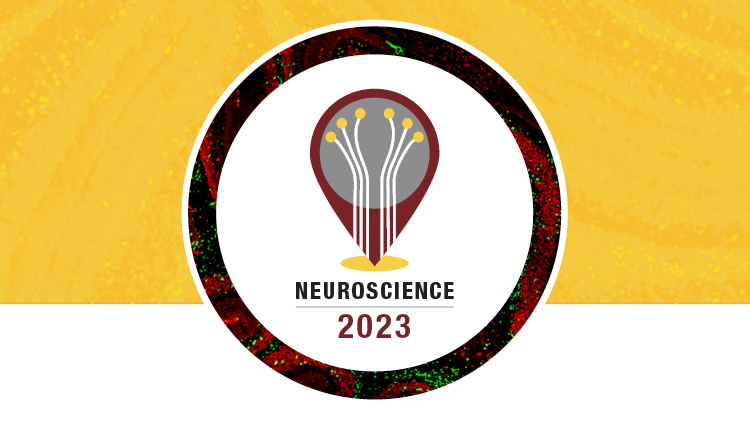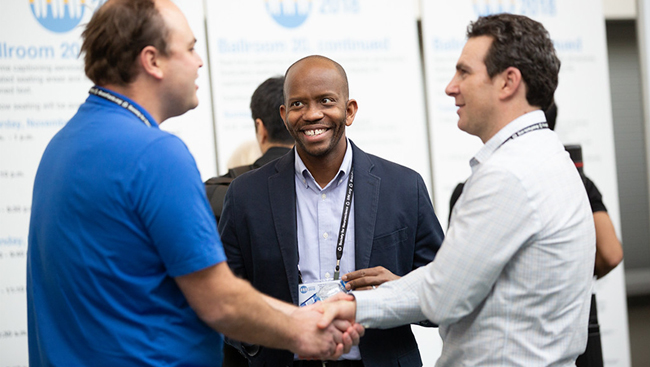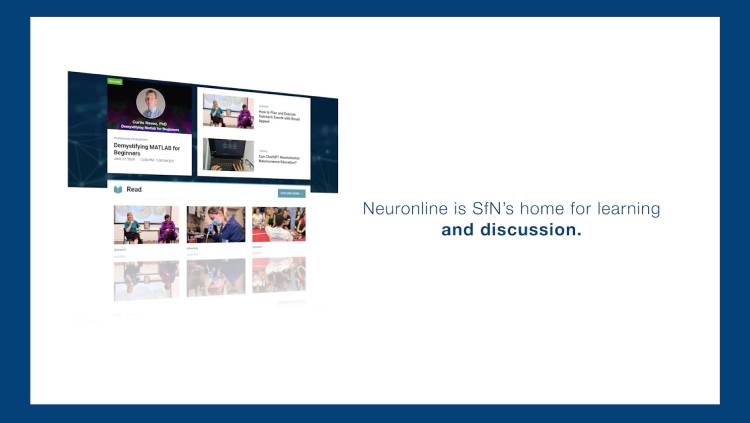
![]() Access a searchable transcript of this video by clicking the magnifying glass icon in the player.
Access a searchable transcript of this video by clicking the magnifying glass icon in the player.
Join past Program Committee Chairs Sheena Josselyn and Ellen Lumpkin and Trainee Advisory Committee Member Stephanie Sandoval-Pistoriusas they discuss how to submit an impactful abstract for Neuroscience 2023, which will be held in Washington, D.C. on November 11 – 15. During this webinar you will learn some insightful tips on submitting your abstract and the presenters will be available to answer any questions that you may have during this time.
Q & A from How to Submit an Impactful Abstract for Neuroscience 2023
Can an author submit an abstract which is recently published where he/she is the first author?
An author cannot submit an exact replica of a recently published study — the abstract/presentation must present new, unpublished data. That said, you can include some published data that sets the stage for the new, unpublished studies.
Is it OK to add an additional author to the poster after the abstract has been submitted and accepted?
It is best to include authors in the published abstract so that they are properly credited; however, if a new author contributes to the study after the abstract is submitted, but before the poster is presented, you can certainly include them on the poster.
Can I submit an abstract for a project that is halfway done, but there are no concrete results to talk about by the abstract deadline?
It is fine to include some preliminary data, but your abstract should include some conclusions. Just saying "results will be discussed" isn’t sufficient.
Can you add more data from the date of abstract submission to the poster presentation?
Absolutely! More data is always welcome.
I unknowingly self-plagiarized three to four words of one of my previously published article titles, is it a big issue?
A: A three-to-four word phrase is NOT plagiarism unless you have crafted a unique phrase. Plagiarism involves copying words or re-using ideas without properly citing the source.
How many characters/words should be in the abstract for Neuroscience 2023?
The body of the abstract should be no more than 2,300 characters, including punctuation but not spaces.
How numerical should one be when mentioning results/data in an abstract? Is it effective to show p-value, for example? Or is stating significant increase/decrease effective enough?
It is important to show that your science is rigorous. Including stats and p-values can show this.
What is important in consider in writing a concise conclusion and implications section of the abstract?
Think about how you would summarize the overall impact of your work to a non-scientist in their 30's. This is the concise conclusions/implications.
Can abstracts contain figures?
Images may be included with abstract submission. Each image included reduces the character count by 500 characters.
Would it still be acceptable to include only some preliminary data (e.g., behavioral data) and indicate that functional imaging data will be presented at the conference? (Due to the fact that this project has just begun).
This seems fine if the behavior data shows something interesting. Then you can layer the imaging results in the poster.
At this moment, I will submit data to SfN that should be published soon but will have new data by the time of poster presentation. How should I state that in the abstract submission?
Describe the results you have. Abstracts that are vague (e.g., ‘new data will be discussed’) can be rejected by the program committee.
I have some results, but I didn’t publish them yet (ongoing) Can I participate with a poster with those results even if they are not published yet.
Absolutely, we love unpublished results! Hopefully the feedback you receive at the meeting will help to get your data published.
What is your opinion on the “#betterposter” format.
It is an interesting format. SfN encourages a more traditional poster so that even if the presenter is not present, the poster can be understood.
Do we need to submit the results too with the abstract?
Your abstract submission must discuss results. Abstracts that state that “results will be discussed” will be rejected.
Is it possible to submit multiple abstracts from a single project? If so, how different do they have to be in terms of methodology and results?
Each abstract should be written independently so that the methods are not in the exact same words. The results should differ between the abstracts.
Do we need to submit the conference paper later?
Only the abstract will be published from this meeting.
I really want to present my results at SfN but I may have published this work just before the conference. Does that mean I can't include this work?
You can submit results that are not published by the date of abstract submission. If you later submit the paper, be sure to write a new abstract rather than self-plagiarizing your SfN abstract.
I really want to present my results at SfN, but I may have published this work just before the conference. Does that mean I can't include this work?
You can submit results that are not published by the date of abstract submission. If you later submit the paper, be sure to write a new abstract rather than self-plagiarizing your SfN abstract.
The abstract should include the support grant number?
There is a field in the abstract submission portal to include any grant and support details. If you have grant support, you should include it in submission.
The results I currently have are included in a manuscript that is under submission. I can describe them, but I wouldn't have something new for abstract submission. Do you have any suggestion about this?
You can submit these data as they have not yet been published and are novel. Hopefully they will be published soon!
If I submit an abstract now, and the corresponding paper will be submitted soon too and might not be published until the conference, is that already a problem with regard to non-original research?
Not a problem.
I read under embargo policy part that at the time of abstract submission, the study should not have been previously published verbatim as a scientific article or meeting abstract. I wonder if it means that we cannot preregister the studies that we have included in the abstract until October? The text under embargo policy: "Research within an abstract to be presented at an SfN event is embargoed until the start of the in-person presentation of the abstract."
The goal of SfN is to advance science. I don’t believe that the embargo would preclude an author from pre-registering their studies. SfN just wants scientists to present novel results. In the context of the meeting, I interpret this policy to mean that the authors should not discuss the research with the press or media.
Are AI text tools allowed to be used in writing an abstract assuming they are properly supervised, and the abstract is fact checked and corrected by a human with proper due diligence?
The current SfN guidelines do not address the use of AI tools.
Do you have any tips for writing an abstract for network science research applied to neural networks (connectomics)?
The relevance of your research to the nervous system must be clear in your abstract. A study that doesn’t relate to the nervous system could be rejected by the Program Committee.
I have one major finding for my abstract that fulfills the description provided by Dr. Josselyn. I have ongoing experiments that haven’t yet generated conclusive results but are important elements of my overarching “story.” Is it appropriate to include /very/ preliminary data from these experiments as results, even though these findings may be subject to change by November?
Yes, but emphasize the conclusions you can already make. Then discuss the ongoing studies.
Can I have multiple paragraphs in the abstract?
Yes, you can format it this way, but the character count remains in place.
I'm using neuro-computational models, can I avoid describing the specific model I used? Can I just say it is a biologically plausible model for reproducing and explaining certain behavior/phenomena?
You should include an adequate description of the methods.
If a figure with subfigures is included for the abstract, does that count as a single image or multiple?
It is better to NOT include figures in the abstract.
Should abstracts have citations?
Often abstracts do include citations as a way of placing your question and results in context. But this is not absolutely required.
What advice would you give to young undergraduate students who are submitting an abstract for the first time?
Use this as an opportunity to practice explaining the highlights of your research to a non-expert audience. And have fun at Neuroscience 2023!!
A previous question asked about including a figure, with the response of "It is better to NOT include figures in the abstract." Why is this the case? Are there certain reasons that someone *should* include a figure?
The abstract review software doesn’t make it easy to see the figure. Abstracts that use the space to describe the research in a rigorous and transparent manner are more valuable to the reader.
When are all the abstracts posted online? and when they are posted is that when we can see what other posters are in our same session?
Accepted abstracts will be published on the Neuroscience Meeting Planner in September. At this point, poster presenters will be able to see the other posters in their sessions.
Do the posters for nanosymposium require to apply along with multiple colleagues? (i.e multiple posters from the same group?)
Ideally, you and your colleagues will form a linking group and submit a nanosymposium. The posters don’t have to be from the same group (in fact, only two can be from the same lab). But they should be organized around a cohesive theme or topic. That said, you are welcome to indicate that you’d prefer to present in a nano even if you don’t make an entire linking group.
Are dynamic posters back for DC?
Dynamic posters will not be part of the Neuroscience 2023 program.
What are the dimensions for the poster?
We will have a webinar in the fall about how to prepare your poster! Your poster must fit on a poster board that is 4 foot by 6 foot.
Why do you often extend the deadline for abstract submission? Usually, I rushed to submit my abstract by the deadline just to find out the deadline has been extended for another week.
Sometimes abstract submission is extended if the server gets overloaded by many presenters submitting just before the deadline. Extensions to the deadline are not guaranteed so ensure you are working on your submission before the deadline of June 14 at 5 p.m. ET.
Can the posters be just background and methods/aims during submission? I am hoping to get some results but that’d be after the deadline closes.
Your abstract must describe some results, even if they are preliminary.
What are your thoughts on a graphical abstract at the end of the abstract? I am aware it takes away 500 words, but is it usually a good thing or a bad thing to do from experience?
As an abstract reviewer, I find the graphics to be unhelpful.
Do you have written guidelines for who should be co-authors on an SfN abstract or poster versus who might be on a related paper?
The guidelines for abstract authorship are the same as those for publications. See the CreDit taxonomy for details.
Speakers



Who can attend these webinars? This webinar is open access and registration is complimentary.
Will the webinars be available on-demand? Yes, all webinars will be available to watch on demand after the live broadcast.
Will a certificate of attendance be offered for this event? No, SfN does not provide certificates of attendance for webinars.
How do I access the conference on the live day? After registering, you will receive a confirmation email with the event link and the option to download calendar reminders.
What are the technology requirements for attending? These webinars are hosted on Zoom Webinar. Instructions for joining and participating in a webinar can be found here.
Can I ask the presenters questions? Yes! You can submit any questions before the webinar through the registration form. During the webinar, you can submit questions through the Q&A box.
I have other questions not answered here. Email digitallearning@sfn.org with any other questions.
Review SfN’s Code of Conduct, rules for virtual events in the Digital Learning Community Guidelines, and communications policies regarding dissemination of unpublished scientific data, listed below. SfN asks that conference attendees respect the sensitivity of information and data being presented that are not yet available to the public by following these guidelines:
- Do not capture or publicly share details of any unpublished data presented.
- If you are unsure whether data is unpublished, check with the presenter.
- Respect presenters' wishes if they indicate that the information presented is not to be shared.
Webinar Refund Policy
What is the cancellation/refund policy for webinars?
If SfN changes fundamental details of the webinar (date, time, or speakers), non-member registrants may request a registration refund. To request a refund, please email digitallearning@sfn.org at least 48 hours before the event. Otherwise, refunds are not provided. All webinars are complimentary to SfN members.
SfN webinars can be watched on-demand if someone is unable to attend the live broadcast.










